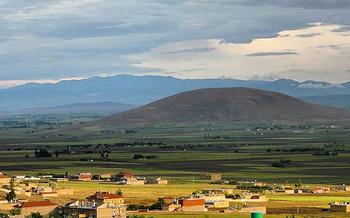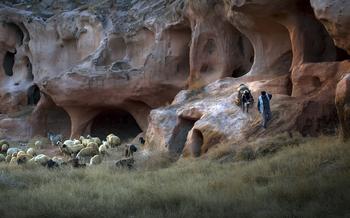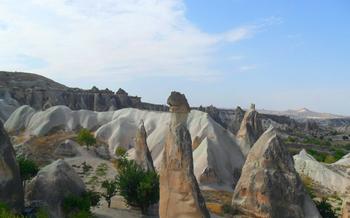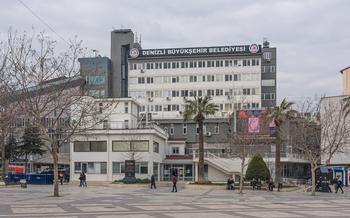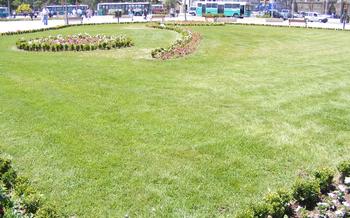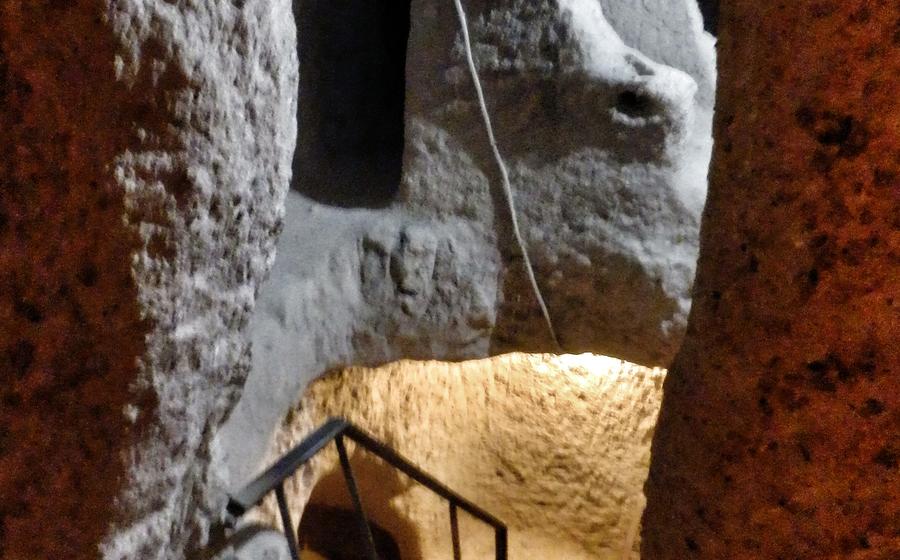
Kaymaklı Underground City
- Historical Background
- Location and Accessibility
- Architectural Marvel
- Religious Significance
- Living Quarters
- Storage and Food Supply
- Defense Mechanisms
- Discovery and Excavation
- UNESCO World Heritage Site
- Accommodation and Dining
- Shopping and Souvenirs
- Cultural Events and Festivals
- Insider Tip
Historical Background
The Kaymaklı Underground City, carved into the soft volcanic rock of Cappadocia, stands as a testament to the ingenuity and resilience of ancient civilizations. Its origins can be traced back to the Phrygians, an Indo-European people who inhabited the region during the Iron Age. They constructed the initial chambers and tunnels, seeking refuge from invaders and harsh weather conditions.
As centuries passed, the city expanded and evolved under the rule of various empires. During the Roman period, it served as a hideout for early Christians fleeing persecution. The Byzantines further developed the city's infrastructure, adding churches, chapels, and sophisticated ventilation systems.
In the 11th century, the Seljuk Turks conquered Cappadocia and transformed Kaymaklı into a strategic military outpost. They enlarged the city, creating new rooms and passageways, and reinforced its defenses. The city's intricate layout, with its hidden entrances, escape routes, and secret chambers, allowed the inhabitants to withstand sieges and invasions.
Location and Accessibility
The historical marvel of Kaymaklı Underground City is situated in the heart of Nevşehir, a province in the captivating Cappadocia region of Turkey. Nevşehir, renowned for its intriguing underground cities and awe-inspiring fairy chimneys, is easily accessible via various means of transportation, making it a convenient destination for travelers seeking an unforgettable subterranean adventure.
To reach Kaymaklı from major cities in Turkey, travelers can opt for comfortable bus services or rent a car for a scenic road trip. The city lies approximately 20 kilometers south of Nevşehir city center and 75 kilometers southwest of the iconic city of Kayseri. The well-connected transportation network ensures a hassle-free journey to this subterranean gem, inviting visitors to delve into its hidden depths and discover its captivating history.
Architectural Marvel
The Kaymaklı Underground City stands as a testament to the ingenuity and architectural prowess of its ancient inhabitants. Its labyrinthine network of chambers and tunnels, carved deep into the soft volcanic rock, reveals a remarkable feat of engineering. The city comprises multiple levels, each featuring a variety of rooms and spaces that served various purposes.
The living quarters, with their compact yet functional layout, demonstrate the efficient use of space. Kitchens, storage areas, and even ventilation systems were meticulously planned and integrated into the underground complex. The ventilation system, in particular, played a crucial role in maintaining a breathable atmosphere within the city, ensuring the well-being of its residents.
The Kaymaklı Underground City also boasts an intricate water system, another testament to the advanced engineering skills of its builders. Cisterns and channels were strategically placed throughout the city, collecting and distributing water for various purposes, including drinking, cooking, and irrigation. The presence of these systems highlights the importance of water management in sustaining life within the underground city.
Religious Significance
Kaymaklı Underground City holds a significant religious connotation, serving as a refuge for early Christians fleeing religious persecution. Evidence suggests the presence of churches and chapels within the city, indicating its role as a religious center. The influence of Christianity in the region is palpable, and the city's history is deeply intertwined with the spread of Christianity in Anatolia.
Living Quarters
The living quarters within the Kaymaklı Underground City were carefully designed to accommodate the needs of its inhabitants. The rooms, ranging in size from small chambers to larger communal spaces, were built with functionality and comfort in mind.
The layout of the living spaces was organized to maximize efficiency and practicality. Each room served a specific purpose, from sleeping and dining to storage and religious observances. The rooms were connected by a network of tunnels and passageways, allowing for easy movement throughout the city.
Inside the living quarters, the walls were often adorned with intricate carvings and paintings, adding a touch of beauty and artistry to the subterranean environment. The rooms were equipped with essential amenities, such as ventilation systems to ensure a constant supply of fresh air and water storage facilities to meet the daily needs of the residents.
Storage and Food Supply
The inhabitants of Kaymaklı displayed remarkable ingenuity in ensuring their food supply within the confines of the underground city. They employed a variety of techniques to store and preserve food, demonstrating their resilience and adaptation to their unique environment.
Food storage played a crucial role in sustaining the community. Cereals, such as wheat and barley, were stored in large underground granaries, kept cool and dry to prevent spoilage. Fruits and vegetables were preserved through drying or pickling, extending their shelf life.
Water collection and distribution were essential for the survival of the city's inhabitants. A sophisticated system of cisterns and aqueducts was developed to collect and store rainwater, ensuring a steady supply throughout the year. Wells were also dug to access groundwater.
Agricultural practices were crucial for supplementing the food supply. The underground city's inhabitants cultivated crops within the city's confines, taking advantage of the stable temperature and humidity. Evidence suggests that they grew vegetables, such as onions, garlic, and lentils, as well as fruits, including grapes and figs.
Defense Mechanisms
The Kaymaklı Underground City was not only a place of refuge but also a formidable defensive stronghold. Its strategic location and ingenious defense systems allowed its inhabitants to withstand enemy attacks and maintain their independence.
The city's most remarkable defensive feature is its intricate network of escape routes and secret passages. These tunnels and hidden chambers provided a means of escape for the city's residents in case of an invasion. The tunnels were narrow and winding, making it difficult for attackers to navigate and pursue the fleeing inhabitants.
In addition to the escape routes, the city also had several other defensive features. The entrances to the city were well-hidden and could be easily concealed. The city's walls were reinforced with massive stone blocks, making them impenetrable to enemy weapons. The city also had several guard towers and observation posts, allowing the inhabitants to keep a watchful eye on the surrounding area and spot any approaching threats.
The strategic location of the city also contributed to its defensive capabilities. It was situated on a hilltop, providing a commanding view of the surrounding countryside. This allowed the inhabitants to see any approaching enemies from a distance and take appropriate defensive measures.
These defensive mechanisms made the Kaymaklı Underground City virtually impregnable. It was able to withstand numerous attacks and invasions throughout its history, testament to the ingenuity and resilience of its builders.
Discovery and Excavation
The rediscovery of Kaymaklı Underground City in modern times is a fascinating tale that began in the early 20th century. In 1907, a French scholar named Édouard Laroche stumbled upon an intriguing entrance to an underground complex while exploring the region. Intrigued, he descended into the darkness, discovering a network of tunnels and chambers that hinted at a hidden city beneath the surface.
Excavations and restorations commenced in the 1960s, led by Turkish archaeologists eager to unravel the mysteries of this subterranean world. The process was painstaking and challenging, as the city had been sealed off for centuries and the passage of time had taken its toll.
Despite the difficulties, the archaeological team meticulously cleared debris, reinforced weakened structures, and documented the intricate features of the city. The excavation process revealed a treasure trove of artifacts, providing valuable insights into the lives of the ancient inhabitants.
To this day, ongoing research and archaeological efforts continue at Kaymaklı Underground City. Scholars and experts collaborate to shed light on the city's history, uncovering new information that deepens our understanding of this remarkable hidden gem.
UNESCO World Heritage Site
Recognition of Kaymaklı as a UNESCO World Heritage Site Kaymaklı Underground City's exceptional cultural and historical significance earned it the prestigious designation of a UNESCO World Heritage Site in 20This recognition acknowledges the city's outstanding universal value and its contribution to the world's cultural heritage.
Criteria for Inclusion on the World Heritage List To be inscribed on the World Heritage List, a site must meet at least one of ten selection criteria established by UNESCO. Kaymaklı Underground City satisfied several of these criteria, including:
-
Criterion (i): Kaymaklı represents a masterpiece of human creative genius, showcasing the ingenuity and architectural prowess of ancient civilizations in creating a subterranean city of remarkable complexity and functionality.
-
Criterion (ii): The city exhibits a significant interchange of human values over a span of time, reflecting the cultural, religious, and defensive needs of its inhabitants throughout history.
-
Criterion (iii): Kaymaklı bears unique or exceptional testimony to a cultural tradition or civilization, providing valuable insights into the lives and practices of ancient communities that sought refuge and protection underground.
Importance of Preserving the City's Cultural Significance UNESCO's recognition of Kaymaklı as a World Heritage Site underscores the importance of preserving and protecting this unique cultural treasure. The designation ensures that the city receives international recognition, support, and resources for its conservation and management. It also raises awareness of the site's significance and encourages responsible tourism practices that contribute to its long-term sustainability.
Accommodation and Dining
Accommodation near Kaymaklı
Nevşehir offers a variety of accommodation options for visitors to Kaymaklı, catering to different budgets and preferences. For a truly immersive experience, consider staying in a traditional Turkish guesthouse or "pansiyon." These guesthouses often feature charming architecture, cozy rooms, and warm hospitality. For those seeking modern comforts, several hotels in Nevşehir offer a range of amenities, including comfortable rooms, swimming pools, and fitness centers.
Local Restaurants and Cuisine
Nevşehir's culinary scene offers a delightful blend of traditional Turkish flavors and modern culinary creations. Savor the region's signature dishes, such as "testi kebabı," a clay pot dish with tender meat and vegetables, or "Nevşehir mantısı," delicate dumplings served with a tangy yogurt sauce. Don't miss the opportunity to try "kapama," a slow-cooked lamb dish with aromatic herbs and spices. For a taste of local delicacies, visit the lively markets and sample fresh fruits, vegetables, and handmade pastries.
Tips for Authentic Turkish Dining
To fully immerse yourself in Turkish cuisine, venture beyond the main tourist areas and seek out local restaurants frequented by locals. Ask your hotel or guesthouse for recommendations, as they can often point you towards hidden culinary gems. Don't be afraid to try new dishes and embrace the vibrant flavors of Turkish cuisine. "Afiyet olsun!" (Enjoy your meal!)
Shopping and Souvenirs
As you explore the charming streets of Nevşehir, take the opportunity to immerse yourself in the local shopping culture and discover unique souvenirs and handicrafts that reflect the region's rich history and traditions. From vibrant carpets and intricate pottery to handwoven textiles and gleaming jewelry, there's something for every taste and budget.
Stroll through the bustling local markets, where vendors display their wares and haggle with customers in a lively atmosphere. Browse through colorful stalls selling fresh produce, spices, dried fruits, and traditional Turkish delights. Don't miss the opportunity to sample some of the local delicacies, such as gözleme (savory stuffed flatbread) or lokum (Turkish delight).
If you're looking for more unique souvenirs, visit the local artisans' workshops and galleries. Here, you can find handmade ceramics, glassware, and woodwork that showcase the skill and creativity of local craftsmen. Each piece is a testament to the region's rich history and cultural heritage.
Remember to embrace the art of bargaining when shopping in Turkey. It's a customary practice that allows you to engage with the locals and get the best prices. Don't be afraid to haggle politely and respectfully, and you might just walk away with a treasure at a fraction of the original price.
Whether you're looking for a unique souvenir to cherish or simply want to experience the vibrant shopping culture of Nevşehir, you'll find plenty to delight your senses and take home as a memento of your travels.
Cultural Events and Festivals
Nevşehir is a vibrant city with a rich cultural heritage that comes alive during various local festivals and events. These celebrations offer a glimpse into Turkish traditions, history, and way of life.
One of the most famous festivals is the Nevşehir International Cappadocia Balloon Festival, held annually in July. This spectacular event features hundreds of colorful hot air balloons taking flight over the stunning Cappadocia landscape. Visitors can enjoy breathtaking views as the balloons soar through the sky, creating a magical atmosphere.
For those interested in history and culture, the Nevşehir Museum Festival takes place in September. This festival showcases the region's rich history and heritage through various exhibitions, workshops, and performances. Visitors can learn about the ancient civilizations that inhabited the area and explore the region's diverse cultural heritage.
If you happen to be in Nevşehir during the summer, don't miss the Nevşehir Summer Festival. This lively festival features a variety of events, including traditional Turkish music and dance performances, art exhibitions, and outdoor concerts. It's a great opportunity to experience the vibrant energy and hospitality of the local community.
Attending these festivals and events is an excellent way to immerse yourself in Turkish culture and gain a deeper understanding of the region's history and traditions. Be sure to check the local calendar for event dates and plan your visit accordingly.
Insider Tip
To fully immerse yourself in the wonders of Kaymaklı, consider visiting during the off-season, between October and April. The crowds are fewer, allowing you to explore at your own pace and capture the city's essence without distractions. Plus, the cooler temperatures make for a more comfortable journey through the underground tunnels.
As you navigate the city, keep an eye out for secret spots and hidden gems. Behind one unassuming door, you might stumble upon a hidden cistern or a forgotten chamber that reveals a glimpse into the city's past. Capture these moments with your camera to create a lasting memory of your journey.
Finally, take the time to engage with the locals, who are always ready to share their stories and experiences. Their insights will enrich your understanding of Kaymaklı and the surrounding region.


